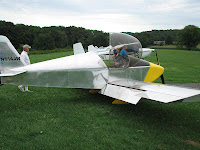It was not the crystal clear blue sky kind of day I had hoped for. Instead I saw deep red glowing beneath the overcast as the sun started to peek above the ridge to the east. "Red sky in morning..."
Coffee started, I sat down at the computer to check the weather pages. Forecast stunk. The METAR dots spread across the weather map were primarily blue, a sprinkling of red and a mix of green. Blue means marginal VFR, and in this case it was due to poor visibility. Mist or fog or both were causing visibility to be less than 5 miles and in some cases (red dots) less than 3 miles. However the ceilings (or the bottom of the overcast) were way up there and not a factor. I decided to drink my coffee and see if daytime warming would improve the conditions. No bothersome TFRs today, the campaign must be somewhere else.
The 8:00am weather conditions had improved, at least good enough for some local flying. A line of green and yellow NEXRAD composite returns blocked my travel to the southeast but it looked relatively good to the west. At least good enough to give it a try. I poured some coffee into a Chinet cup and headed over to Butter Valley.
To my surprise there was a tent set up on "my" taxi way! And a volleyball net! Closer inspection showed that I could get past if I altered my normal path just a bit, but not too far or I would be sideways on wet grass crossing a rather steep hill. Sure that my path was clear I went over to the hangar to start my preflight.
All ground operations were normal and the taxi turned out to be a non-issue. After the run up I looked across the turf to see a flock of brown geese eating their breakfast. There was no wind so I had my choice of runways and decided to take off to the north. Once airborne I found the weather to be calm, ceilings high but visibility restricted to less than 10 miles. So I stayed low and headed south toward N47. When we were coming home from a day trip last week we had wondered about a fork in the road and where it went. At 1500' it was easy to see where it split off from Rt100 and wandered into Pottstown.
I made a 180 to fly back to the north. I stayed clear of N47 and KPTW airspace and chose a track toward Quakertown. Smooth calm air, to travel over the Pennsylvania countryside, not even a burble in the air. I started checking terrain alerts with visual identification against what Sally was calling out. I picked out obstructions at about 5 miles, Sally alerted me at about 3 miles. Good system.
Passing Rt309 I decided to follow that south for awhile. I tuned in the CTAF and used the monitor function as I passed KCKZ. It's fun to follow a well known path to see landmarks from the air. After awhile I decided to let Sally fly and punched the Direct button to make our way back to 7N8.
But it was too nice to call it quits. I overflew the airport and continued in a generally northwest direction taking me directly over Bally Spring Farm. Sally told me to switch tanks...45 minutes already. There was a cell phone tower off to my right and Sally called it for me (as well as the smaller one to the left). We crossed the ridge and entered the Lehigh Valley. With 3 gallons in the right, 5 gallons in the left, it was time to go home.
A flight of two Citabias had entered the pattern at 7N8. I came in from the 45 and gave them both time to land and back taxi before I called final. A very nice landing today. I back taxied and cut across the lawn in front of the tent, crept past the volleyball net and gunned it to get up the hill. I shut her down with 1:06 on the flight clock.









